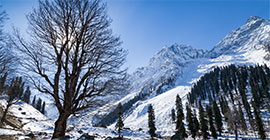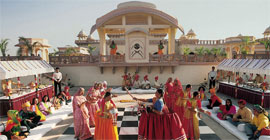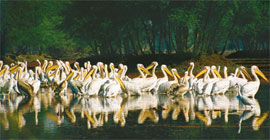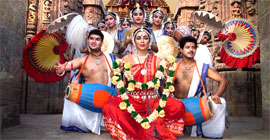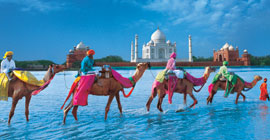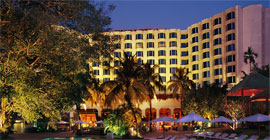AGRA
Home | Agra
Taj Mahal
Taj Mahal of India - "the epitome of love", "a monument of infinite beauty". The beauty of this bravura monument is such that it is beyond the scope of words. The thoughts that come into the mind while watching the Taj Mahal of Agra is not just its phenomenal beauty, but the immense love which was the reason behind its construction. Mughal Emperor Shah Jahan got this monument constructed in the memory of his beloved wife Mumtaz Mahal, with whom he fell in love at the first sight. The very first sight of the Taj Mahal, the epitome of love and romance leaves one mesmerized. Eminence colonially on the banks of River Yamuna, the Taj Mahal is tantamount with love and romance. It is believed that the name "Taj Mahal" was derived from the name of Shah Jahan wife Mumtaz Mahal and means "Crown Palace". The purity of the white marble, the exquisite ornamentation, precious gemstones used and its picturesque location, all make Taj Mahal travel gain a place amongst the most popular ones. However, unless and until, one knows the love story behind the Tajmahal of India, it will come up as just a beautiful building. But, the love behind this outstanding monument is what has given a life to this monument.
Agra Fort
Agra Fort Built predominantly as a military institution by Akbar in 1565, the red sandstone Agra fort was partially converted into a palace during Shah Jahan's time. Though the principal structure was built by Akbar, many more additions were made by his grandsons. This massive fort is 2.5 kms long and is considered as the predecessor of the Delhi Red fort. The colossal walls are 20 feet high and the whole fort is delimited by a fetid moat. Amar Singh gate towards the south is the only entry point in the fort. The building and structures inside the fort gives an impression of a city within the city. Many of the building inside the fort is now closed for the public. The marble pearl mosque inside the fort is one of the most stunningly beautiful mosques in India. Agra Fort is located on the banks of the Yamuna near the railway station. Agra is well connected by air with Khajuraho, Varanasi, and Delhi. It has good rail and bus connections with major Indian cities. From the city, there are taxis, tempos, auto-rickshaws, and cycle rickshaws to carry one to the fort. Prepaid taxis and autos from the railway station are also available. Bicycles can also be hired on hourly basis.
Monuments Inside The Agra Fort : Diwan-e-Am, Diwan-e-Khas, Octagonal Tower.
Fatehpur Sikri
Fatehpur Sikri is one of the optimum examples of Mughal architectural splendor at its height. Though the city is in ruins, it is a place to visit if one comes to Agra. But in real terms Fatehpur Sikri is a place where one should spend some time. The sunset over the ruins is sight to cherish. Fatehpur Sikri is the best example of the culmination of Hindu and Muslim architecture. Fatehpur Sikri Mosque is said to be a copy of the mosque in Mecca and has designs are derived from the Persian & Hindu architecture. Entrance to this mosque is through the 54 meter high Buland Darwaza, which was built in April 1575, to commemorate Akbar's victory over Gujrat. To the North of the Mosque is the Dargah of Shaikh Salim Chishti. This Dargah was built in 1570. Here, childless women come for blessings of the saint. Even Akbar was blessed with three sons, when he came here. The lattice work in the Dargah is among the handpicked to be found any where in India. 37 kms from Agra is built a city predominantly in Red Sandstone called Fatehpur Sikri. This town was built by the Mughal Emperor Akbar. He had planned this city as his capital but shortage of water compelled him to abandon the city and within 20 years the capital of Mughals was shifted to Lahore.
Monuments of Fatehpur Sikri : Ankh Michauli, Diwan-i-Khas- Hall of Private Audience, Buland Darwaza, Panch Mahal, Khwabgah, Anup Talao.
Jahangir Mahal
The Jahangir Mahal, Agra is glaring example of a daring approach in architecture. The brackets which are so typical of the Gujaratis feature animal and floral motifs which are fabulously carved. They also register a dominating effect on the few Islamic features such as the verandah on the eastern front with exquisitely slender pillars facing the riverfront. The city of Agra lies on the banks of the Yamuna River in India. This medieval city was found by Sultan Sikandar Lodi in the year 1506. The city has achieved fame as the capital of the Mughal emperors from 1526 to 1658. It is today a major tourist destination in India and tourist from all over India and the world come here to admire the fascinating architecture. Some of the splendid Mughal era buildings include Taj Mahal, Agra Fort and Fatehpur Sikri , all three of which are UNESCO World Heritage Sites. Jahangir Mahal is the most important building of the Akbari period in the Agra Fort. The Jahangir Mahal in Agra boasts a splendid gateway which leads to an interior courtyard surrounded by grand halls covered with profuse carvings on stone, heavily fashioned brackets, piers, and crossbeams. You can still spot the remains of decorations in gold and blue done in the prevalent Persian style. The features of the Jahangir Mahal are mixed in Transoxanian or Central Asian features such as the verandah on the east front with its high slender columns with courtyard halls styled in the broader Gujarat-
Ram Bagh
Rambagh Gardens in Agra, a beautiful Mughal pleasure Garden, are located 3 Km from the Tomb of Itimad ud Daulah and 500 m from the Chini Ka Rauza. You can visit the lovely Rambagh Gardens in Agra, on tours to Agra with Agra Hub. The Mughal Emperors of India, were very influenced by their Persian background. In Persia, the pleasure garden is an important part of the landscape of every city. The Mughal emperors introduced the same concept in India. In Islam, the garden is considered a representation of Paradise, a word derived from pairidesa, which means land of fairies. Devout Muslims should not only aspire to reach paradise but should strive to create its likeness on earth. Therefore the Mughal Emperors laid out many beautiful gardens to create a paradise within their kingdoms. You can see the beautiful Rambagh Gardens in Agra, on tours to Agra with Agra Hub.
Dayal Bagh
Dayal Bagh is Situated at a distance of about 13 kms from the city center, Dayal Bagh is tourist destination. The headquarters of the Radhasoami Satsang, located in Agra, India, Dayalbagh means 'Garden' (bagh) of 'Mercy' (daya), inferring "Garden of the Merciful Lord". The place is sacred to followers of Radha Swami Faith where the 8th revered leader (Sant Satguru) lives and presides over the satsang (holy service). The Technical College and Women's Training College and Dayalbagh Educational Institute (deemed university) are important institutes in the region. Raja Ki Mandi Railway Station is the nearest station and the Agra Airport is 14 kms away from Dayal Bagh. Tourists to Dayal Bagh can have great time shopping in the shopping markets for varied products. These markets offer several souvenirs just for souvenir lovers. Ajay Carpet Company is recommended for buying carpets and rugs. Guests to Dayal Bagh can choose to stay in Lauries Hotel, Paying Guests, and Service Apartments. During their stay, they can admire the beautifully decorated and planned region of Agra. Dayal Bagh is tourists' delight as if offers numerous attractions worth exploring including Bageshwarnath Temple, Mangleshwar Temple, Ram Bagh, Chini Ka Rauza. The memorial of Swamiji Maharaj is prime attraction of the region. Started on 1904 A.D. and is believed never to be ended, the structure is a blend of mosque, temple and gurudwara architecture. The lofty structure was constructed in white marble. Radha Swami Institute is throng by devotes to pay homage to Swami Maharaj.
Mehtab Bagh
The Mehtab Bagh, a 25 acre garden plot constructed during 1631 to 1635 AD, is the moonlight garden located along the western side of bank of the river Yamuna. It is laid just across the Yamuna, aligned with the world famous Taj in a symmetrical style. This is the ideal location from where one can view the perfect beauty of Taj Mahal under the romantic glossy moon light. This garden is one of the most attractive gardens in Agra and it replenish the grandeur era of Mughal dynasty in the minds of the traveler. This picturesque area is now converted into the epic centre of the eco-friendly environment developing around Taj Mahal. The soft cool breeze from Yamuna and the fragrance of the colored flowers in the garden are sure to attract all visitors to this romantic place.
Anguri Bagh
Angoori Bagh is situated infront of the Khas Mahal.It was established by Akbar the Great for his empress and other ladies of his 'Harem'. It is said that the soil for this was brought from Kashmir.The garden is surrounded by double storied building on three sides.
Chini-Ka-Rauza
Mulla Shukrullah Shirazi was the Prime Minister of Mughal emperor Shah Jehah and also a famous poet. He composed poetry under the pseudonym of 'Allami'. He took fancy to building his own mausoleum in 1639 with elaborate ornamentation. He chose glazed tiles as his medium to create the masterpiece that would enshrine his tomb forever. Every portion of this unique monument is profusely adorned with bright color schemes, known as 'Chini ka Rauza'. Here, we discuss the general plan and layout of the building and the ornamentation techniques used in the monument in detail.
Itmad-Ud-Daulah's Tomb
Itmad- Ud - Daula, notorious as the "Baby Taj", it is the first tomb in India built entirely in white marble. It was built in 1628 by Nurjahan, wife of Emperor Jahangir, for her father Mirza Ghiyas Beg, an Imperial Officer who had received the title of Itmad-ud-Daula (Pillar of Government). The mausoleum rests in a walled garden close to the Yamuna river, approximately one and a half kilometers upstream of the Taj Mahal. Itmad-ud-Daulah's tomb is a highly ornate edifice, which is looked upon as an imminent precursor of the Taj Mahal as far as elaborate carvings and inlay work are concerned. The tomb marks a significant departure from the tombs of the Mughal dynasty built before its construction. Itmad-ud-Daulah was buried in a tomb that resembles a jewel box and set in a garden. This tranquil, small, garden located on the banks of the Yamuna was to inspire the construction of the Taj Mahal in the later years. For the general information to tourists planning their vacations in Agra, the tomb of Itmad-ud-Daulah is the first tomb in India built entirely in white marble. The tomb is also justly famous for the glorious pietra dura (stone inlay) decoration depicting cypresses, wine glasses, and an amazing variety of geometrical arabesque. The jali screens set in arched recesses are splendid. Four small minarets rise at the four corners of the small tomb structure. The whole structure gives the impression of an enlarged precious object. Due to the profusion of intricate work done on marble and the beautiful marble screen-work, the tomb easily qualifies as a veritable forerunner of the famous Taj Mahal. The tomb of Itmad-ud-Daulah in Agra is a must-visit for tourists on vacations in Agra.
Sur Sarovar Keetham Lake
The Sur Sarovar is a picturesque lake located about 23 km away from Agra, in Uttar Pradesh. Also known as the 'Keetham Lake', this astounding water body has always been a favorite haunt for group picnickers and nature lovers. Its serene beauty is said to have had influenced the poetic imagination of the great Sur Das. This lake has been the inspiration for him to pen 'Bhakti Kavya,' a devotional poem. Sur Sarovar falls under the Sur Das Reserved Forest and was declared as a National Bird Sanctuary in 1991. More than 100 species of migratory and native birds are found in this 7.13 sq km of tranquil paradise. Major bird species found here are gadwals and shovellers, bar-headed geese, brahminy ducks, sarus cranes, Siberian cranes and spoonbills. It is also home to more than 18 species of reptiles and 12 species of mammals. September to March constitute the tourist season.
Jama Masjid
The Jama Masjid at Fatehpur Sikri, near Agra is also known as the Jami Masjid. The mosque is one of the largest in India. It was constructed in 1571 A.D. during the reign of the Mughal Emperor Akbar the Great. The mosque is built at a height due its exalted purpose and has a large courtyard where the faithful can gather to pray. To the right of the mosque is the Jammat Khana hall and then the Zenana Rauza, or the tomb of the women of the royal household. The Jama Masjid is exquisitely decorated with inscriptions, inlaid geometric designs and colored tiles. The building is symmetrically proportioned and has an austere beauty, befitting its religious purpose. You can see the Jama Masjid Agra on tours to Agra with Agra Hub. The main entrance to the Jama Masjid mosque in Agra, is through the grand gateway known as the Buland Darwaza. Another entrance is though the Badshahi Darwaza. The Jama Masjid Agra is the center of the city of Fatehpur Sikri, which was built around it. You can see the city of Fatehpur Sikri and its heart the Jama Masjid, on tours to Agra with Agra Hub
Buland Darwaza
The Buland Darwaza is a grand gateway sited in Fatehpur Sikri near Agra. This triumphal arch was built by the Mughal Emperor Akbar, when he conquered the king of Khandesh or Gujarat in 1573. The name Buland Darwaza means 'High Door' and this triumph arch rises to a height of 40 meters or 175 feet. It is the most prominent monument in Fatehpur Sikri and can be seen from quite a distance. Rising impressively towards the sky, the Buland Darwaza is approached by a series of steps. You will pass under the massive arch of the Buland Darwaza when you enter the city of Fatehpur Sikri. You can see the impressive Buland Darwaza on tours to Agra with Agra Hub. The Buland Darwaza is a magnificent structure built in red sandstone with decorations in white marble. With calligraphic inscriptions from the Quran on its front and pillars and chattris on its height, the Buland Darwaza is an impressive sight. The Buland Darwaza is also evidence of the religious tolerance of Akbar the Great. The inscription on the Buland Darwaza is attributed to Jesus Christ. It reads, "The World is but a bridge, pass over but build no houses on it."
Bharatpur
The Bharatpur Bird Sanctuary is also known as the Keoladeo Ghana National Park. This bird sanctuary is a few hours drive from Agra and offers bird lovers the fascinating sight of hundreds of resident birds nesting in the trees alongside the marshes of Bharatpur. The Bharatpur Bird Sanctuary was beforehand the bird hunting reserve of the Maharaja of Bharatpur. He built an reproduction marsh consisting of raised earthen bunds and water channels. The trees growing on the bunds give birds a place to perch and nest and the underwater roots and beetles give the birds enough food to feed on. You can travel to Bharatpur and observe the graceful birds of this bird sanctuary, on tours from Agra with Agra Hub. Some of the birds you can see at the Bharatpur Bird Sanctuary are storks, cranes, many kinds of water fowl, kingfishers, jays, parakeets, drongoes, barbets, and many migratory birds in winter including various kinds of ducks from central Asia. Until a few years ago the rare Siberian Crane was seen here in winter. Bharatpur is a favorite of wildlife photographers and bird watchers. The ornithologist Dr Salim Ali was responsible for Bharatpur Bird Sanctuary being confirmed a National Park in 1982. Bharatpur was declared a World Heritage site in 1985. Agra Hub offers tours of Bharatpur where you can see the beautiful birds at the Bharatpur Bird Sanctuary on tours from Agra India.
Mathura
Mathura is located in the north Indian state of Uttar Pradesh and is one its prominent pilgrim destinations. It is the place where one of the most revered Hindu deities - Lord Krishna was born, according to legends. Archaeological evidence points to the fact that Mathura was the hub of a rich culture and civilization during the ancient times and thus was the home to a large number of marvelous buildings that were built here. Find more about the tourist information on Mathura before you set out for a tour to this sacred place. Mathura has its mention in the Ramayana, one of the oldest epics of the world. Earlier it was thickly forested and was called as Madhuvan then Madhupara and later on came to be known as Mathura. In the 6th century BC, Mathura became the capital of the Shursen republic and after that it was ruled by the Maurya Empire and later on by the Sunga dynasty. Archaeological evidences reveal that, by 100 BC, Mathura was inhabited by the groups of Jains. The culture and creative pursuits of Mathura touched its pinnacle under the Kushan dynasty that declared it as their capital. Mathura was demolished several times by the Mughal rulers and was later on ruled by the Jat kings of Bharatpur but after that was annexed by the Marathas.
Vrindavan
Vrindavana and Mathura are the most imperative places of pilgrimage for devotees of Krishna. Krishna was born in Mathura and spent His childhood in Vrindavan. There are over 5,000 temples in Vrindavan. The city of Mathura, in Uttar Pradesh, the nucleus of Brajabhumi, is located 140 km south-east of Delhi and 60 km north-west of Agra. Covering an area of about 3,800 sq. km., Brajabhumi can be divided into two distinct units - the eastern part in the trans-Yamuna tract with places like Gokul, Mahavan, Baldeo, Mat and Bajna and the western side of the Yamuna wrapper the Mathura region that encompasses Vrindavan, Govardhan, Kusum Sarovar, Barsana and Nandgaon (Nandagram). The land of Braj starts from Kotban near Hodel about 95 km from Delhi and ends at Runakuta which is known specially for its association with the poet Surdas, an ardent Krishna devotee. A long line of picturesque ghats - with their steps leading to the water's edge, arched gateways and temple spires extending along the right bank of the River Yamuna, emphasize the sacred character of the town of Mathura.







